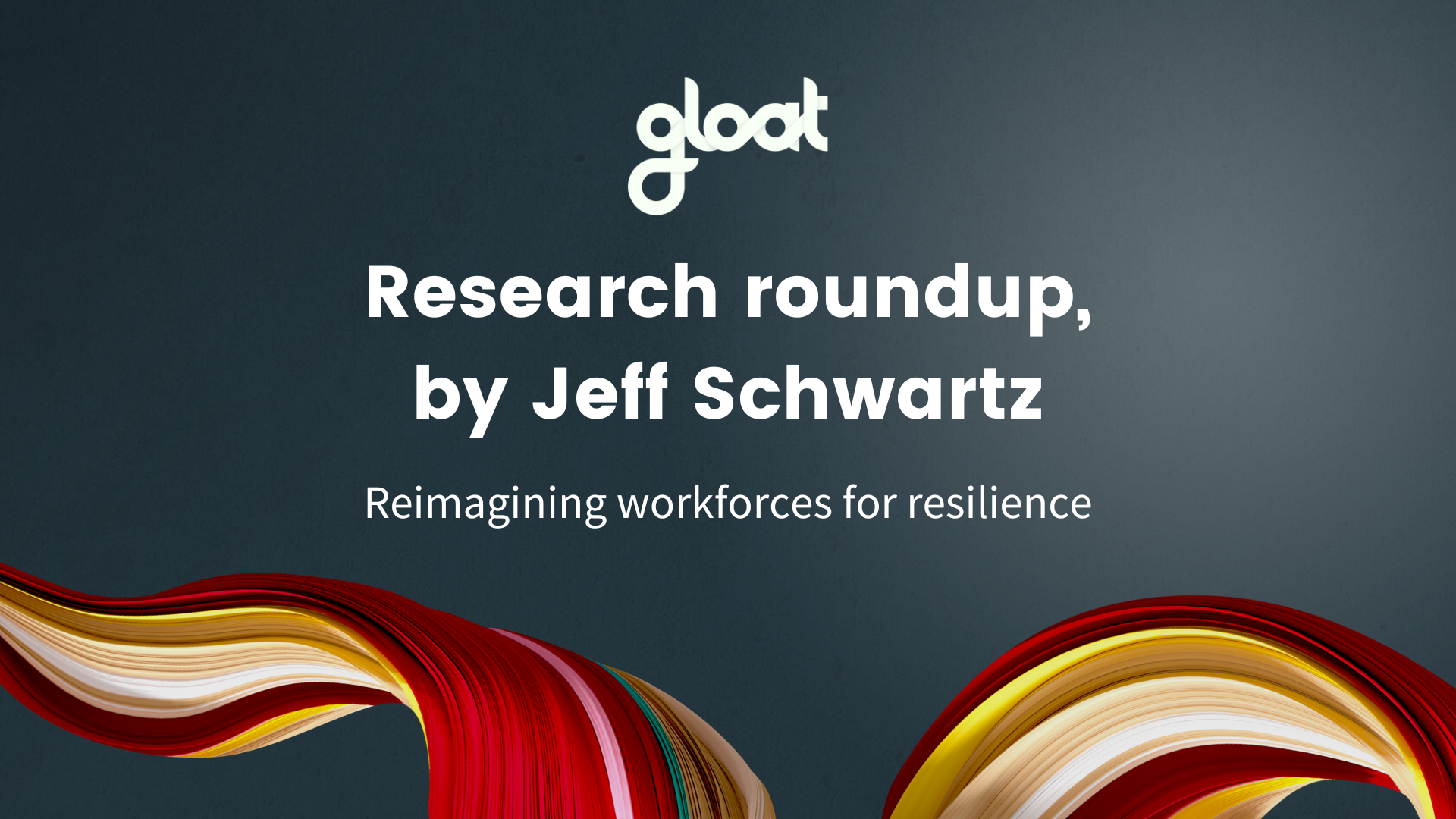July research roundup: reimagining workforces for resilience
What I am reading, listening to, and thinking about in the world of talent marketplaces and workforce intelligence

At the start of 2022, I suggested that reimagination would be one of the most important themes of the year—maybe the decade. In the months that followed, several events unfolded that underscore the importance of this idea: rising inflation, market turmoil, supply chain disruptions, and the ongoing talent shortage.
Businesses won’t be able to overcome these emerging challenges by sticking to the status quo. Leaders must explore new strategies rooted in purpose, agility, and talent agency to ensure their business can thrive in the face of unprecedented disruption. From shifting the focus of skill and career development to striking the right balance for hybrid working, every element of work and the workplace must be re-examined.
While this magnitude of change is inherently challenging, the reward is well worth it: resilience. Only businesses that commit to unlocking agility and transforming their ways of working will be prepared to meet and prosper from the challenges that lie ahead. This month’s research roundup is dedicated to spotlighting the foundational themes and frameworks that will be at the heart of every resilient organization’s winning strategy.
Here’s what leaders need to prioritize to push their reimagination journeys forward during turbulent times:
READ What’s new in thought leadership about the future of work
Internal Talent Mobility Programs Can Advance Gender Equity. Do Yours?, Boston Consulting Group, by Nithya Vaduganathan, Colleen McDonald, and Gabrielle Novacek
Now that companies are facing a moment of reckoning in the workplace, many organizations are striving to move the needle on diversity, equity, and inclusion. Yet, some leaders are struggling to pinpoint the tools and frameworks that will turn these well-intentioned ambitions into realities. Boston Consulting Group’s piece explores the role that internal mobility programs and talent marketplaces play in advancing gender equity. Their article spotlights the success our partners at Seagate have had with their platform—including an impressive 58% increase in the participation and assignment of women to open internal positions.
It’s Time to Reimagine Employee Retention, Harvard Business Review, by Helen Tupper and Sarah Ellis
When it comes to talent management, many managers find themselves between a rock and a hard place. While the pace of turnover is forecasted to be 50-75% higher, it’s also taking 18% longer to fill roles than it did pre-pandemic. That means team leads are grappling with widening knowledge gaps as they struggle to retain all-star employees. Fortunately, the authors of this piece have some advice for leaders in the midst of this turnover tsunami: focus on career progression, rather than promotion. Tupper and Ellis offer three solutions that enable managers to support people in growing beyond their teams, in turn increasing the likelihood that top talent will choose to stick around. Creating a skills marketplace that allows managers to profile projects based on the expertise they require and match it with the experience available within the business is one of my favorite takeaways from this piece.
New Research Shows That High Growth Large Companies Have Distinct HR Skills, JoshBersin.com, by Josh Bersin
Josh Bersin breaks down some interesting findings about the kinds of capabilities that tend to fuel business growth. Notably, high-growth companies have HR teams that can partner with senior leaders, coach managers and executives, and have a deep understanding of the business’s operations. These top-performing organizations also have a well-defined HR operating model and strong skills in corporate learning and learning technology. Interestingly, recruiting skills aren’t one of the top capabilities, and Bersin suggests it’s because companies can no longer grow through recruiting alone. Instead, high-performing businesses prioritize development, mobility, retention, and strategic job design.
The Great Attrition is making hiring harder. Are you searching the right talent pools?, McKinsey.com, by Aaron De Smet, Bonnie Dowling, Bryan Hancock, Bill Schaninger
Most leaders know that finding skilled talent isn’t easy. As employees continue to quit at record levels, businesses must think outside of the box to bridge knowledge gaps and ensure their workforce has the skills they need to succeed in the new world of work. McKinsey suggests considering five different types of workers and describes each persona, which includes the traditionalists (career-oriented, full-time employees), the do-it-yourselfers (employees who value flexibility and autonomy and gig workers), the caregivers (parents and care-takers who are looking for more flexible work), the idealists (students and young part-timers), and the relaxers (retirees and those not looking for work).
LISTEN What I’ve been playing on repeat
AI Talent Marketplace and Workforce Agility Platform Gloat Raises $90 Million, Cheddar News
Want to learn a little more about Gloat’s recent Series D funding round and what this means for the future of workforce agility? Hear about it directly from co-founder and CEO Ben Reuveni, who recently joined Cheddar News’ Closing Bell to discuss how talent marketplaces are helping businesses like PepsiCo and Mastercard analyze their employees’ skills, experience, and career aspirations—and match them to relevant opportunities and projects.
Gloat—The AI Talent Marketplace Creating an Agile Workforce, The Tech Talks Daily Podcast, with Neil C. Hughes
I really enjoyed catching up with Neil C. Hughes on a recent Tech Talks Daily Podcast episode dedicated to exploring talent marketplaces and the shifts in future of work priorities. In this episode, we discuss the benefits these platforms provide, as well as some suggestions for forward-looking business leaders who are looking to succeed long-term as the world of work undergoes major changes and unprecedented disruptions.
Lynda Gratton on evolving HR for tomorrow’s world of work, Gloat.com, with Lynda Gratton
Author and management professor Lynda Gratton shared four steps to rethinking work structures through design thinking at a recent Gloat Book Club session. Her best practices include taking time to understand what goes into various roles and how these jobs align with employee ambitions, embracing experiments like four-day work weeks and remote-first working, evaluating these against your business goals and fairness, and finally, thinking about the steps needed to enact these changes.
Building a resilient strategy for the economic slowdown, Gloat.com, with Kathi Enderes, Josh Bersin, and Heather Yurko
There’s no doubt that building resilience during an economic slowdown is exceptionally challenging, which is why we dedicated a recent Gloat Learn webinar to strategizing for it. The discussion features industry analyst Josh Bersin, The Josh Bersin Company’s Senior VP of Research Kathi Enderes, and Heather Yurko, VP of Digital Talent at Mastercard. There are plenty of game-changing tips throughout their conversation, as well as some advice for leaders who are looking to launch a talent marketplace to give their business an edge.
THINK What research and studies are saying about our path forward
The Great Resistance: Getting employees back to the office, Stanford Institute for Economic Policy Research, Nicholas Bloom
Another challenge that is topping the list for managers and leaders today is about getting employees back to the office, or what Nicholas Bloom refers to as The Great Resistance. While some organizations are attempting to halt or reduce flexible working options, many employees aren’t having it. In an age where talent is scarce and the hiring landscape remains competitive, do return to office mandates really make sense? Bloom offers his thoughts, as well as a few tips for navigating the Great Resistance and doing hybrid working the right way.
CONNECT What future-fit organizations and leaders are talking about
Investing for a resilient and inclusive future of work, Tanuj Kapilashrami, Linkedin
Here at Gloat, we don’t just talk about the frameworks that businesses need to succeed in the new world of work; we have a robust community that demonstrates what these best practices look like in action, including Standard Chartered Bank. This piece by their Group Head of Human Resources, Tanuj Kapilashrami, explores how the leading financial services institution has transformed the way they work and democratized access to opportunities. Since piloting their talent marketplace back in 2020, Standard Chartered Bank has unlocked productivity worth over $2.1 million and empowered more than 14,000 employees to access over 600 cross-functional and cross-geography experiences.
Lori Niles-Hofmann, Linkedin
Lori Niles-Hofmann, co-founder of the educational transformation consultancy NilesNolen, has something important to say to L&D teams: it’s time to start taking advantage of a talent marketplace. Niles-Hofmann explains that a symbiotic relationship between EdTech and a talent marketplace is going to be a game-changer in the new world of work. Rather than being caught off-guard, she suggests spending some time with talent teams to learn more about their plans for transformation and internal mobility.
Let us know what you would add to our list.





